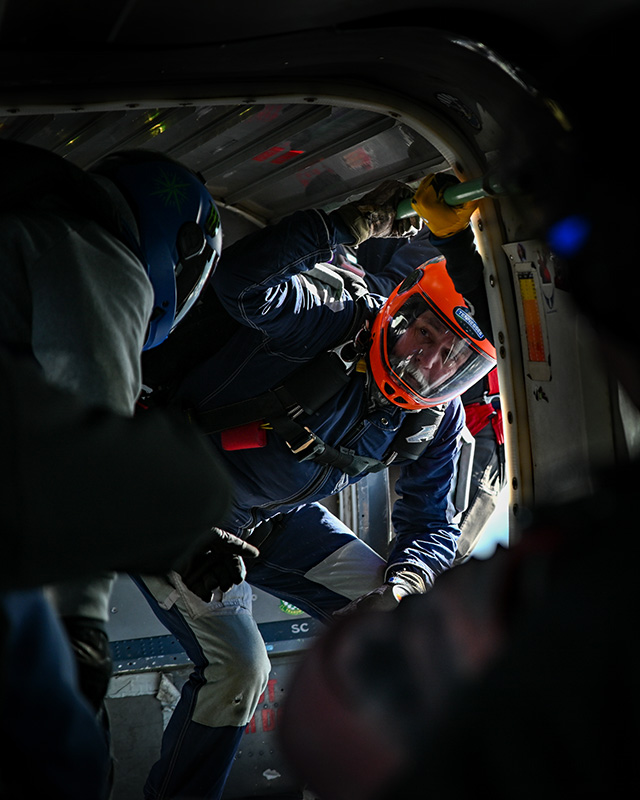Above: Photo by Ori Kuper
Laurel and Hardy, Wilbur and Orville Wright, Fred Astaire and Ginger Rogers. History is full of great partnerships. Crucial to every skydive is a partnership that you probably seldom think about: the partnership between you and your pilot. Fred Astaire was a terrific dancer, but with every move he made, Ginger Rogers was right there with him, dancing backwards in five-inch heels!
On every jump run, while you are in the back of the airplane hand-jiving and fist bumping your buddies without a care in the world, your pilot is up front doing their own version of dancing backwards in five-inch heels. There is a lot that goes into skydiving airplane operations and flying jumpers, and skydivers need to understand what’s happening with the airplane so they can take an active role in the airplane ride and jump run.
Regardless of whether you are jumping from a Cessna 182, a CASA 212 or something in between, the same physical laws–some of which are under control of the skydivers on board–are in effect and determine whether the airplane flies safely:
- Weight and balance
- Weight distribution during exit
- Airplane configuration
- Parasitic drag
- Airspeed and pilot control of the airplane
Weight and balance are a critical part of airplane flight for every aircraft, jump plane or not. Each airplane is limited to a total amount of weight it can carry and how that weight is distributed. So, there is a reason for seat-belt placement and why you sit in specific locations in the airplane. The weight distribution for each position in the fuselage has already been calculated, and sitting in specific locations on the floor helps to ensure that the airplane remains balanced during the flight. Speaking of seat belts, you are wearing one, right? It’s required for taxi, takeoff and landing with the airplane.
Your pilot has a lot to do during each flight, but jump run is where it gets busy. While approaching the exit point, he or she is making radio calls to air traffic control and broadcasting on the local air traffic frequency, adding flaps, reducing power to slow the airplane to a designated airspeed and maintaining a specific heading. Once all that is done and the airplane is near the exit spot, the pilot will indicate that it is safe for you to open the door and check the spot while also looking around for any other airplanes before beginning your climb-out and exit.
Whether it is a verbal command in a Cessna 182 or 206, or lights beside the door in a Cessna Caravan or other large jump plane, skydivers must know and understand how the pilot will communicate that it is safe to open the door and exit. A tail strike can occur if a skydiver exits while the airplane is still in a climbing configuration. Tail strikes have led to serious injuries and fatalities, so it is important to learn what a correct plane configuration looks like on jump run.
Chis Schindler, longtime skydiving airplane safety advocate and owner of diverdriver.com, spent many years flying skydivers in Twin Otters before moving to a successful career as an airline captain. Schindler states, “Jump-run configuration with aircraft that have a horizontal stabilizer in-line with the jump door have the highest hazard of an in-flight collision with the exiting skydiver. Make sure you understand how the aircraft is to be configured and do not exit until it is in that configuration, even if the green light is on, or you could be the one colliding with the tail.”
A unique aspect of flying skydivers comes into play during jump run, which is when you and your pilot really need to cooperate with each other. The pilot has a strong desire to keep the airplane flying safely, while you and your jumping buddies sometimes appear to have a keen interest in making that as difficult as possible. As your group gathers in the door of the airplane preparing to exit, two things begin to happen at the same time:
- The weight begins to shift noticeably toward the back of the airplane
- Skydivers outside of the door of the airplane create large amounts of parasitic drag and block airflow across the horizontal stabilizer
 Photo by Eddie Phillips.
Photo by Eddie Phillips.For those two reasons, it is important that skydivers move efficiently and exit as quickly as possible, and the later groups need to stay forward toward the pilot while waiting for their turn to leave. Too much weight in the rear of the airplane can cause the airplane to stall. Anything outside of standard exit procedures must be discussed with the pilot ahead of time to make sure what you are planning will work.
J.P. Furnari, senior pilot and check airman for Desert Sands Aircraft has spent two and a half decades skydiving and almost half that time flying skydivers in both Cessna Caravans and Twin Otters. He states, “Planning and communication are key to safe jump runs, as well as respecting the weight and balance limitations of the aircraft. Jumpers should rehearse their exits at the mockup until they are as efficient as possible to minimize time spent in the door, and larger group exits should be communicated to the pilot during the loading process. Keep in mind that once the pilot begins to taxi and until a safe altitude has been reached (usually a minimum of 1,500 feet above the ground), distracting the pilot for anything less than an emergency can be hazardous and should be avoided.”
He continues, “Minimize movement in the climb, because changes in CG (center of gravity) reduce efficiency and are a distraction to the pilot. On jump run, when a large group is in the door, all other jumpers should remain forward to minimize the aft-CG situation. With many small groups, the later groups out don’t need to be on the heels of the groups ahead of them Move down gradually to minimize the change in CG.”
While skydivers are climbing out and moving toward the door of the airplane, the pilot is working hard to keep the airspeed where it needs to be while maintaining wings level, heading and pitch attitude. The bodies outside of the airplane not only shift the weight toward the rear, but they also disrupt the airflow moving across the horizontal stabilizer, reducing effectiveness and making it harder for the pilot to avoid a stall. In a Cessna 182, the weight shifts to the right landing strut and there is a large amount of drag created by the jumpers outside of the airplane, requiring a lot of work by the pilot to keep the airplane flying correctly. So, a quick climb-out and exit is in order even in the smaller jump planes. In short, while you are focused on your exit, your pilot is up front keeping track of a bunch of things all at the same time. The more you can expand your situational awareness to include what’s happening with the airplane on jump run, the more you can help keep exits moving smoothly and safely.
If too many skydivers move toward the back of the airplane at the same time, a large amount of the weight shifts toward the back and moves the tail of the airplane down to a point where the outside jumpers can disrupt the airflow moving across the surface of the horizontal stabilizer, making it less effective for the pilot to control the pitch of the airplane. At the same time, the airplane slows down due to the flatter pitch and all the drag created from skydivers hanging on the outside of the fuselage. If the airplane stays in this configuration for very long, it can lead to a stall and loss of control. A stall can be something as benign as a slight buffet, or it can lead to a rapid, spinning descent that can be difficult or sometimes impossible for the pilot to recover. If a stall should occur, there is no exact procedure for skydivers to follow because there are so many variables.
Regarding a stall, Schindler states, “If the airplane begins to buffet (bucking up and down) jumpers on the outside of the airplane need to immediately let go of the airplane! This will both move the center of gravity forward and remove the turbulent airflow that may be affecting the tail.” Depending on the altitude and how the airplane is flying, the jumpers inside the airplane might need to either try to get to the door and exit or move forward toward the pilot to move the CG forward. There are lots of variables involved, and every situation will be different. The pilot should tell the remaining jumpers what they need to do.
On any given weekend, hundreds of jump planes carry thousands of skydivers safely to altitude. And while it may seem like a routine process, a lot goes into ensuring each flight goes smoothly. Skydivers play an important part in that process, whether it is a conscious effort or not. But the more you know and understand about what goes on in the front of the plane, the safer you will be and the easier you can make life for your pilot. And they can use all the help they can get, because dancing backwards in five-inch heels is a tough job.
 About the authorokok
About the authorokok
Jim Crouch, D-16979, spent 3,000 hours flying skydivers in various jump planes including a Cessna 182, Cessna Caravan, and Beechcraft C90 King Air while he owned two different drop zones. He was USPA Director of Safety and Training from 2000-2018 and he now happily flies other people’s airplanes around the country conducting aerial survey flights.